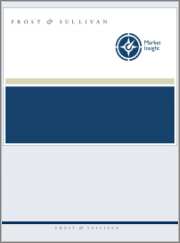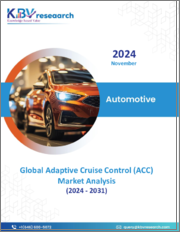
|
시장보고서
상품코드
1408138
L2+ 핸즈오프 어시스트 운전의 성장 기회Growth Opportunities in L2+ Hands-off Assisted Driving |
||||||
경쟁 심화로 2030년까지 640만 대의 자동차에 탑재, CAGR 53.3%로 증가할 전망
자동차 산업의 가치사슬은 전통적인 피라미드형에서 플랫형으로 변화하고 있습니다. 기술 기업들은 주문자상표부착생산자(OEM) 및 단계별 공급업체와 협력하여 운전자의 편안함과 편의성을 높이는 핸즈오프 운전을 가능하게 하는 첨단 운전 보조 기술을 개발, 검증, 공급 및 통합하고 있습니다.
SAE J3016TM Levels of Driving Automation은 레벨 2(L2+ )를 공식적으로 인정하지 않지만, 자동차 업계는 레벨 2와 레벨 3(L3)의 자율 주행(AD) 사이의 능력과 요구 사항의 격차를 메우는 자율 주행 레벨로 간주합니다.
생태계 기업들은 다양한 방식으로 L2+ 를 정의하고 있습니다. 그러나 대부분의 OEM은 L2+ 를 핸즈오프 보조 운전과 동일시하고 있으며, 운전 활동을 모니터링하고 필요에 따라 역동적인 운전 작업을 대신할 수 있어야 한다는 점이 L2+ 의 핸즈오프 운전이 더 많이 채택되면 자율주행 기술이 소비자들에게 더 많이 받아들여지고 확산될 것으로 보입니다. 확산될 것으로 예상됩니다.
초기 L2+ 첨단운전자보조시스템(ADAS) 시장은 미국 시장에서 핸즈오프로드 주행보조시스템과 같은 기능을 제공하는 신흥 OEM 업체들이 주도했습니다. 현재, 경쟁이 치열해짐에 따라 기존 OEM들도 L2+ 차량에 핸즈 오프 기능을 제공함으로써 ADAS 기능을 도입하고 있으며, L2+ ADAS 시장은 프리미엄 및 대중 시장 OEM, 특히 어댑티브 크루즈 컨트롤(ACC), 차선 유지 보조(LKA)와 같은 ADAS 시스템을 장착한 고가의 OEM들이 주도하고 있습니다. LKA)와 같은 ADAS 시스템을 장착한 고가의 플래그십 차량이 주도하고 있으며, OEM은 3-5년 내에 이러한 제품을 L2+ 핸즈오프 어시스트로 업데이트할 가능성이 높습니다.
이 보고서는 L2+ 세계 시장에 대한 기술 및 경쟁 상황을 파악합니다. 또한 이 시장의 비지니스 모델, 제품 전략, 성장 기회를 분석하고 2023년부터 2030년까지의 예측을 제공합니다.
주요 과제
- L2+란 무엇인가? AD에 새로운 레벨을 도입하는 이유는 무엇인가?
- L2+ 시장의 주요 촉진요인과 억제요인은 무엇인가?
- 업계 전문가들은 L2+ 시장의 성장을 어떻게 예측하고 있는가? 주요 OEM들은 이러한 추세에 어떻게 대응하고 있는가?
- L2+ 시스템의 기술 로드맵, 부품표, 비용은?
- L2+ 시장의 주요 플레이어와 그 솔루션은 무엇인가?
목차
전략적 원칙
- 왜 성장이 어려워지는가?
- The Strategic Imperative 8(TM)
- L2+ 핸즈오프 어시스트 운전 업계에 대한 전략적 원칙의 영향
- 성장 기회가 Growth Pipeline Engine(TM)을 추진
- 차량 부문
- SAE International에 의한 운전 자동화 레벨의 정의
- ADAS와 AD시장 세분화
- L2+ 핸즈오프 어시스트 운전 세분화
- 주요 경쟁사 : L2+ 핸즈오프 어시스트 운전 업계
- 규제 개요 : L2+ 핸즈오프 어시스트 운전 산업
성장 기회 분석
- 분석 범위
- 성장 지표
- 성장 촉진요인
- 성장 억제요인
- 예측 가정
- 기능 보급 예측
- 지역별 보급 예측
- 기능 보급 예측 : 고속도로 주행 보조 및 도심 주행 보조
- 경쟁 환경
성장 기회 분석 : 유럽
- 성장 지표
- feature 보급 예측
- feature 보급 예측 : 고속도로 주행 보조 및 도심 주행 보조
성장 기회 분석 : 북미
- 성장 지표
- feature 보급 예측
- feature 보급 예측 : 고속도로 주행 보조 및 도심 주행 보조
성장 기회 분석 : APAC
- 성장 지표
- feature 보급 예측
- 기능 보급 예측 : 고속도로 주행 보조 및 도심 주행 보조
L2+ 핸즈오프 어시스트 운전 산업 개요
- L2+ 핸즈오프 운전 지원이란 무엇인가?
- 왜 자동차 업계는 L2+ 핸즈오프 어시스트 운전을 추진하는지?
- L2+ 핸즈오프 운전 지원의 주요 동향
- L2+ 핸즈오프 운전 로드맵
- L2+ 시스템의 주요 컴포넌트
- 대표적인 L2+ 고속도로 어시스트 센서 스위트와 가격 분석(OEM 용)
- 대표적인 L2+ 도시외 어시스트 센서 스위트와 가격 분석(OEM 용)
- L2+ 핸즈오프 운전 어시스트 밸류체인
- 핸즈오프 운전 기능을 전개하는 비지니스 모델
- L2+ 생태계
L2+ 핸즈오프 어시스트 운전 업계 : 주요 테크놀러지 기업
- Mobileye SuperVision
- NVIDIA DRIVE AutoPilot
- Qualcomm Snapdragon Ride 플랫폼
- 경쟁 상황 : L2+ 솔루션 : 테크놀러지 개발 기업
L2+ 핸즈오프 어시스트 운전 업계 : 주요 Tier I 공급업체
- ZF L2+ 솔루션 포트폴리오
- Continental L2+ 솔루션 포트폴리오
- APTIV L2+ 솔루션
- 봇슈 L2+ 솔루션
- 경쟁 상황 : L2+ 솔루션 : Tier I 공급업체
L2+ 핸즈오프 어시스트 운전 업계 : 주요 OEM 프로파일
- Nissan ProPILOT 2.0
- Nissan ProPILOT 2.0 : 센서 스위트와 차량 전개 전략
- Toyota Teammate
- Toyota Teammate : 센서·스위트와 차량 전개 전략
- GM Super Cruise
- GM Super Cruise : 센서 스위트와 차량 전개 전략
- GM Ultra Cruise
- Ford BlueCruise
- Ford BlueCruise : 센서 스위트와 차량 전개 전략
- BMW Highway Assistant
- 경쟁 상황 : L2+ ADAS : Mass Market OEMs
- 경쟁 상황 : L2+ ADAS : 프리미엄 OEMs
- L2+ 핸즈오프 어시스트 운전 업계에의 OEM 벤치마킹
- 결론
성장 기회 유니버스
- 성장 기회 1 : 고속도로에서의 운전 지원
- 성장 기회 2 : 고도 지각 센서
- 성장 기회 3 : DMS
다음 스텝
ksm 24.02.02Competitive Intensity to Spur 6.4 Million Vehicles Equipped with the Technology by 2030, Increasing at a CAGR of 53.3%
The automotive industry value chain is transitioning from the traditional pyramid form to a flat one. Technology companies work with original equipment manufacturers (OEMs) and tiered suppliers to develop, validate, supply, and integrate advanced driver-assist technologies that enable hands-off driving to enhance the comfort and convenience for the driver.
Although the SAE J3016TM Levels of Driving Automation does not officially recognize Level 2+ (L2+), the automotive industry considers L2+ as an autonomous level, one that bridges the capability and requirements gap between Level 2 and Level 3 (L3) automated driving (AD).
Ecosystem players define L2+ in different ways. However, most OEMs equate L2+ with hands-off assisted driving, where the driver must monitor the driving activity and be available to take over the dynamic driving task when necessary. Higher adoption of L2+ hands-off driving will introduce and drive acceptance of automated driving technologies among consumers.
Initially, the L2 advanced driver assistance system (ADAS) market was driven by emerging OEMs offering features such as hands-off highway driving assist systems in the US market. Now, competitive intensity has compelled traditional OEMs to introduce ADAS features by offering hands-off driving in their L2+ vehicles. The L2 ADAS market is driven by premium and mass market OEMs, especially by their expensive and flagship vehicles that feature ADAS systems such as adaptive cruise control (ACC) and lane-keep assist (LKA). OEMs will likely update these offerings to L2+ hands-off assists in the three to five years.
This study of the global L2+ market highlights its technologies and competitive landscape. The study also includes analyses of the market's business models, product strategies, and growth opportunities, with forecasts from 2023 to 2030.
Key Issues Addressed:
- What is L2+? What are the reasons for introducing a new level in AD?
- What are the key drivers and restraints for the L2+ market?
- How do industry experts expect the L2+ market to grow? How are major OEMs responding to the trend?
- What are the technology roadmaps, bill of materials, and cost of L2+ systems?
- Who are the key players, and what are their solutions in the L2+ space?
Table of Contents
Strategic Imperatives
- Why is it Increasingly Difficult to Grow?
- The Strategic Imperative 8™
- The Impact of the Top 3 Strategic Imperatives on the L2+ Hands-off Assisted Driving Industry
- Growth Opportunities Fuel the Growth Pipeline Engine™
- Vehicle Segmentation
- SAE International's Definitions for Driving Automation Levels
- ADAS & AD Market Segmentation
- L2+ Hands-off Assisted Driving Segmentation
- Key Competitors-L2+ Hands-off Assisted Driving Industry
- Regulations Overview-L2+ Hands-off Assisted Driving Industry
Growth Opportunity Analysis
- Scope of Analysis
- Growth Metrics
- Growth Drivers
- Growth Restraints
- Forecast Assumptions
- Feature Penetration Forecast
- Penetration Forecast by Region
- Feature Penetration Forecast-Highway Assist and Extra Urban Assist
- Competitive Environment
Growth Opportunity Analysis-Europe
- Growth Metrics
- Feature Penetration Forecast
- Feature Penetration Forecast-Highway Assist and Extra Urban Assist
Growth Opportunity Analysis-North America
- Growth Metrics
- Feature Penetration Forecast
- Feature Penetration Forecast-Highway Assist and Extra Urban Assist
Growth Opportunity Analysis-APAC
- Growth Metrics
- Feature Penetration Forecast
- Feature Penetration Forecast-Highway Assist and Extra Urban Assist
Overview of L2+ Hands-off Assisted Driving Industry
- What is L2+ Hands-off Driving Assist?
- Why is the Automotive Industry Promoting L2+ Hands-off Assisted Driving?
- Key Trends in L2+ Hands-off Driving Assist
- L2+ Hands-off Driving Roadmap
- Key Components of an L2+ System
- Typical L2+ Highway Assist Sensor Suite and Pricing Analysis (To OEMs)
- Typical L2+ Extra-urban Assist Sensor Suite and Pricing Analysis (To OEMs)
- L2+ Hands-off Driving Assist-Value Chain
- Business Models to Deploy Hands-off Driving Features
- L2+ Ecosystem
L2+ Hands-off Assisted Driving Industry-Key Technology Companies
- Mobileye SuperVision
- NVIDIA DRIVE AutoPilot
- Qualcomm Snapdragon Ride Platform
- Competitive Landscape L2+ Solution-Technology Developers
L2+ Hands-off Assisted Driving Industry-Key Tier I Suppliers
- ZF L2+ Solution Portfolio
- Continental L2+ Solution Portfolio
- APTIV L2+ Solution
- Bosch L2+ Solution
- Competitive Landscape L2+ Solutions-Tier I Suppliers
L2+ Hands-off Assisted Driving Industry-Key OEM Profiles
- Nissan ProPILOT 2.0
- Nissan ProPILOT 2.0-Sensor Suite and Vehicle Deployment Strategy
- Toyota Teammate
- Toyota Teammate-Sensor Suite and Vehicle Deployment Strategy
- GM Super Cruise
- GM Super Cruise-Sensor Suite and Vehicle Deployment Strategy
- GM Ultra Cruise
- Ford BlueCruise
- Ford BlueCruise-Sensor Suite and Vehicle Deployment Strategy
- BMW Highway Assistant
- Competitive Landscape, L2+ ADAS-Mass Market OEMs
- Competitive Landscape, L2+ ADAS-Premium OEMs
- OEM Benchmarking to L2+ Hands-off Assisted Driving Industry
- The Last Word
Growth Opportunity Universe
- Growth Opportunity 1-Highway-assisted Driving
- Growth Opportunity 2-Advanced Perception Sensors
- Growth Opportunity 3-DMS
Next Steps
- Your Next Steps
- Why Frost, Why Now?
- List of Exhibits
- Legal Disclaimer



















